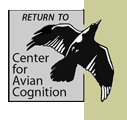


Concealing Coloration
Concealing coloration allows prey animals to blend into the background, making them harder for visual predators to detect (reviewed in Bond 2007, Diamond & Bond 2013). We intuitively tend to think of concealing coloration in terms of our own perceptions: How well does a color pattern correspond to an animal's surroundings? How hard is it for a human observer to find the animal? But visual search is actually a very complex process. In addition to the resemblance between the animal and its background, prey detection is strongly dependent on observation conditions, on characteristics of the predator’s visual system, and on short-term changes in the predator’s focus of attention and searching speed. To reduce ambiguity, Endler (1991) defined a cryptic color pattern as one that resembles a random statistical sample of the background. He proposed to sample patches of color from both the background and the animal, determine the multivariate distributions of hue, saturation, and brightness in each, and then measure crypticity in terms of the correspondence between the two sample distributions.
Endler's definition was primarily in terms of color physics, but crypticity is also affected by differences in spatial frequency, in the mean size and variability of distinctive color patches. The impact of even simple differences in spatial frequency is shown below with a set of six artificial moths (A) on several different background configurations. The intensity histogram of the background in B corresponds closely to that of the moths, but the average spatial frequency is somewhat higher (i.e. background patches are smaller than moth patches). The distinctive local spatial correlations in the moths draw the viewer’s attention, making a contrast to the uncorrelated texture of the background. In C, the background pixels were drawn from independent light and dark intensity distributions that minimally overlapped those of the moths, but the average spatial frequency was reduced (i.e. larger patches, comparable to those on the moths). In this treatment, the moths are less cryptic, in terms of the distribution of gray-scale colors, than the moths in B, but both humans and blue jays find them far harder to detect. In D, both the intensity and the texture distributions of the background match those of the moths. And the moths essentially disappear.
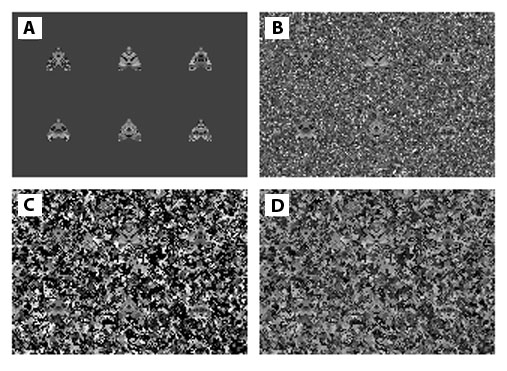 |
There are also effects of the background pattern that are the result of aspects of visual cognition. A background that is intricate and complex, containing many contrasting elements over a range of spatial frequencies, can require a prolonged and careful search, even if the prey are not otherwise particularly cryptic (Bond & Kamil 2006, Bond 2007). This is the basis for the visual puzzles in many children’s books (e.g. Where's Waldo; Handford 1987), in which the task is to locate a particular item in a highly detailed and cluttered image. There may be only a limited resemblance between the item and the distracting elements of the background, but because there is so much information to be processed, the search can be very laborious (Diamond & Bond 2013). We have addressed a variety of aspects of visual search and detection of concealingly colored animals using blue jays (Cyanocitta cristata) searching computer displays for images of cryptic moths.
Experimental System
Underwing moths are one of the most familiar examples of cryptic coloration. They sit motionless on tree trunks during the daytime with their forewings closed over their backs. The color patterns of the forewings resemble the surrounding bark, making them very difficult to detect. An unusual feature of cryptic insects in general, and of forest moths in particular, is that they are often polymorphic -- the individual species occur in multiple, visually distinctive forms. In underwing moths, the polymorphism is mainly in the cryptically colored forewings; the hindwings, which are concealed from view when the insect is at rest, are generally uniform within species.
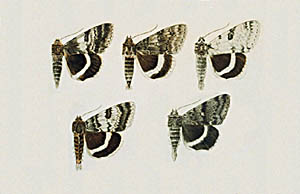 |
| Five forms (or "morphs") of the Relict Underwing Moth,
Catocala relicta. (Revised from Barnes & McDunnough
1918). Note the variable forewings and the relatively uniform
hindwings. |
In North America, blue jays frequently prey on these woodland moths during the daytime. They can pick them off even when these cryptic insects are resting motionless on tree trunks. In the 70s and 80s, Kamil and his students found that jays in the laboratory showed these same impressive detection abilities when the birds were required to locate cryptic moths in slide images (Pietrewicz & Kamil 1977; Pietrewicz & Kamil 1979). We converted this natural predator/prey system into one that could be digitally manipulated, reducing the resolution of gray-scale images of real cryptic moths to 16x16 pixel icons that we overlaid on textured, fractal backgrounds. The backgrounds were reverse-engineered from the moth images, allowing us to produce a broad range of task difficulties.
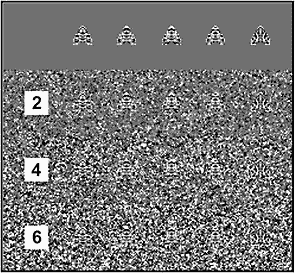 |
Five digital moths displayed on a uniform gray background (top) and on three different levels of cryptic background. With practice, most blue jays have little difficulty detecting moths even at Level 6, though their performance declines at higher crypticities. Jays can only rarely find moths at levels of 8 or 9. |
We presented the moths, one at a time, to the birds in an operant chamber. In each trial there either was or was not one moth image imbedded in one of the fields of cryptic background on a computer monitor (see below). If the bird found a moth and pecked it, the peck was registered by an infra-red touch screen, and the bird was rewarded with a food pellet in the central well below the perch. If the bird did not find a moth, it pecked the green circle, in which case the next trial began immediately. The bird was never informed if it overlooked a moth, and if it pecked an area of background with no moth present, the time to the next trial was substantially delayed. This discouraged random responding.
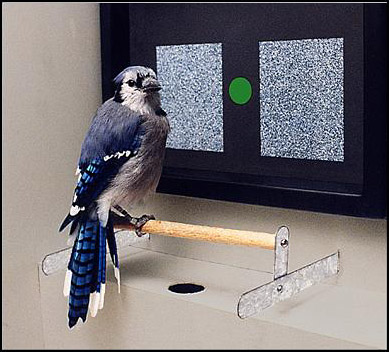
Our initial experiment (Bond & Kamil 1999) validated the technique, showing that it produced effects similar to earlier studies using photographic images. We found that the birds were more accurate at finding moths after a series of trials of the same type of prey than during random presentations of differing prey types. We also found interference effects, in which inducing a jay to search for one type of moth reduced the likelihood of its finding an alternative type.References from Other Sources
Endler, J.A. (1991). Interactions between predators and prey. In Behavioral Ecology, J.R. Krebs & N.B. Davies (eds.), pp. 169–96. London: Blackwell.
Handford, M. (1987). Where’s Waldo? Boston: Little, Brown.
